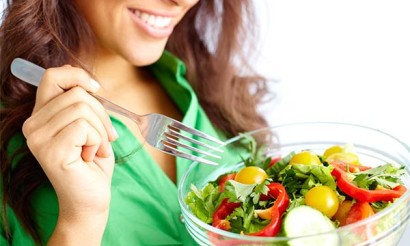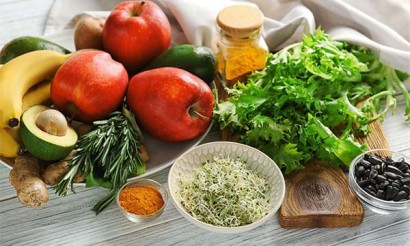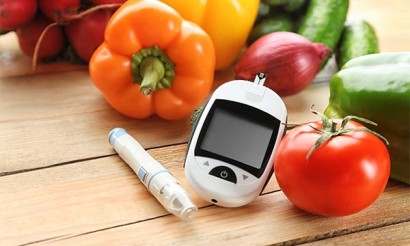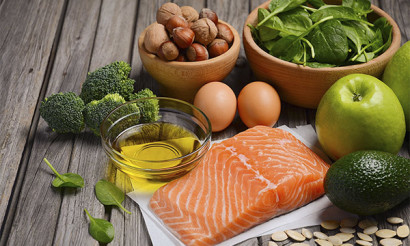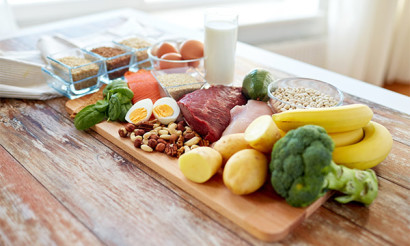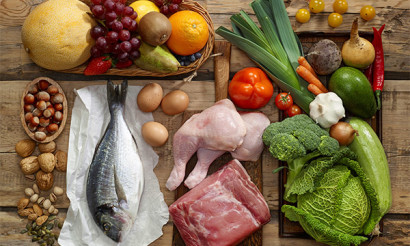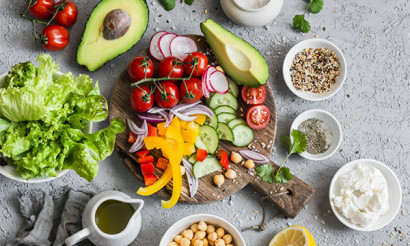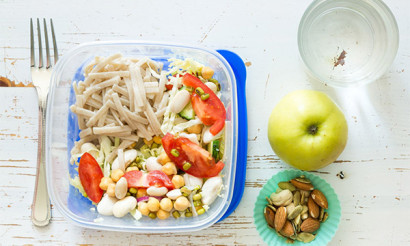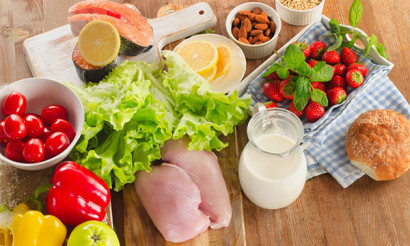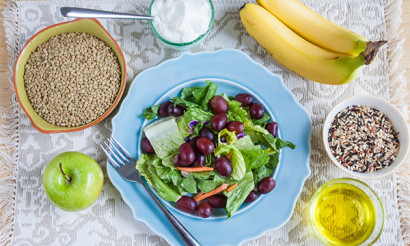Nutrition and diets for hypertension: what you can and can not eat?
Hypertension (or hypertension) - a disease characterized by persistent and prolonged increase in blood pressure. It is caused by disorders of the heart muscle and unstable vascular tone.
- What is this disease
- Nutritional peculiarities
- For men
- For women
- For the elderly
- Basic Principles of Nutrition
- What you can eat when you have high blood pressure
- What to Limit
- What not to eat when you have high blood pressure
- What you can and what not to drink with hypertension
- Top foods that lower blood pressure
- Citrus
- Beets
- Spinach
- Garlic
- Rosehip
- Chicory
- Cocoa
- Ginger
- Buckthorn
- Curcuma
- Pomegranate
- Milk and kefir
- Diets for Hypertension
- Recipes for Hypertension
- Tenderness Salad
- Salad "Special
- Salad "Baby Joy".
- Borsch on the basis of vegetable broth
- Milk soup based on pumpkin and semolina
- Fruit soup cooked on rosehip
- Beef in original sauce
- Diet steak
- Fillet of pike-perch in soft cream sauce
- Inimitable Casserole
What is this disease
According to the WHO standard, high blood pressure is considered to be more than 140/90 mm of the mercury column. The index consists of two numbers: the first is systolic (upper), the second is diastolic (lower). According to statistics, more than 30% of adults suffer from episodes of high blood pressure, which is a symptom of primary hypertension.
Without proper treatment, acute heart failure and myocardial infarction can occur. The insidiousness of the disease lies in the fact that in most cases patients are not aware of the dangerous pathology and do not take any preventive measures. Some states have programs aimed at combating the disease. New safe drugs are being developed, but without a proper lifestyle and diet, drugs are useless.
Nutritional peculiarities
Elevated blood pressure implies a lot of side effects. Let the pathology on its own, it is better to consult a doctor and follow not only the painted medication treatment, but also radically change the way of life and the principles of nutrition.
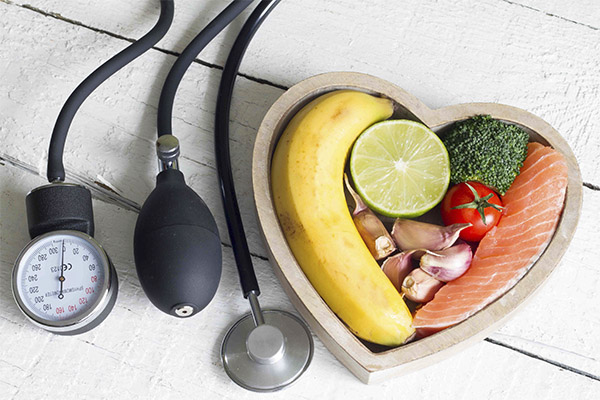
The diet for hypertension is considered not only an important aspect of productive treatment, but also a preventive measure. Observing dietary restrictions does not mean giving up your favorite foods. Proper nutrition during the treatment of high blood pressure attacks with a competent approach is not only useful, but varied and delicious. The necessary food basket allows you to improve the overall performance and condition of the body, because it helps to avoid the progression of pathological conditions and eliminate the unpleasant symptomatology, which is:
- in the decline of performance;
- increased sleepiness;
- absent-mindedness;
- loss of appetite;
- flickers in front of the eyes;
- sweating;
- nosebleeds;
- a pale face;
- Anxiety.
An optimal and balanced diet for hypertension is not an easy task. For unmistakable solution to the difficult problem is reasonable to consult a certified nutritionist. Competently developed menu allows you to achieve:
- Normal blood pressure readings.
- Reduced stress on the heart and circulatory system.
- Eliminate the acute manifestations of hypertension, which prevents the progression and related complications.
The main law to which all the principles of proper nutrition in this disease must obey is a significant reduction of the consumed salts. The level of the latter is recommended to reduce to a minimum. It is better to replace highly salty foods with foods that contain vitamins, trace elements, fiber, healthy fats and reduce the amount of cholesterol in the connective tissues.
Strokes and ischemic necrosis are responsible for over 70% of deaths on the planet. That is, 7 out of 10 people leave this world because of a vascular blockage in the heart or brain. Almost in 100% of cases the cause of death is considered to be pressure drops due to arterial hypertension. It is possible and necessary to lower it, or rather - vitally important. But it will not cure the disease itself, but only helps to deal with the consequences, not with the root causes.
Hypertension is an insidious disease that manifests itself differently in the stronger and weaker sex. Fluctuations are explained by unequal weight categories and peculiarities of the physiology of the bodies, for these reasons the diet for high blood pressure differs. Also, when drawing up a diet plan, experts take into account the age category of the patient. A product that will benefit a young patient, for an elderly person may be potentially dangerous.
For men
Practice shows that the diet of most representatives of the stronger sex mainly consists of fatty and caloric foods, provoking the progression of vitamin deficiency and causing micronutrient deficiencies. Therefore, doctors strongly advise men with confirmed arterial hypertension to take certain foods:
- pomegranates;
- garlic;
- chicken eggs;
- celery;
- seafood;
- red fish.
For women
Because of the peculiarities of the physiology and needs of the body, the fairer sex needs less food than men, so they can more easily endure dietary restrictions. Nutritionists recommend women with hypertension to eat:
- raisins;
- avocado fruit;
- peeled nuts;
- fresh cabbage;
- dried fruits, including prunes and apricots;
- oatmeal;
- white fish;
- cranberries.
Eating a diet balanced by this list allows you to normalize your overall condition without an acute feeling of hunger and saturate your body with amino acids and minerals.
For the Elderly
People of advanced age, in addition to hypertensive manifestations, have a number of other diseases. Therefore, to help elderly patients bring their blood pressure readings back to normal, experts advise changing their habitual lifestyle:
- Minimize stressful situations and psycho-emotional shocks.
- Give up smoking and alcohol.
- Adhere to a system of low-calorie meals.
- Exercise regularly and moderately.
- Keep a diary with evening and daily records of blood pressure values.
- Don't abuse tea and coffee.
- Reduce salt.
If a pensioner has been diagnosed with hypertension, it is recommended to increase the percentage of fruits, vegetables, lean meat, soups cooked on water, dairy and fermented milk products.
Thus, a well-designed diet contributes to the effectiveness of medical drugs, and in the early stages of the pathology leads to the normalization of pressure values without taking medication.
Basic principles of nutrition
Dieticians prescribe people with hypertension to observe the following principles of nutritional behavior:
- Adhere to an eating plan that does not subject the body to severe stress. With a sharp rejection of favorite foods and dishes, a person will get more harm, rather than the desired improvements and benefits.
- Exclude the use of alcohol, coffee drinks and strong teas, all of which contribute to vascular spasms and provoke pressure surges.
- Eat food in small portions at regular intervals, i.e. follow the rules of divided meals. A total diet divided into 5-6 meals prevents harmful overeating for the gastrointestinal tract.
- Give preference to steamed, baked or stewed food.
- Maintain a water regimen. Within a day, at least 1.5 liters of purified fluid should enter the body. If the patient has chronic heart failure and edema, the volume of water per day is reduced to 0.8-1 liters.
- From the menu should be definitively eliminated all fatty and fried foods.
- If you are overweight, which provokes the rapid development of hypertension and high blood pressure attacks, limit the amount of sugar consumed. It is completely recommended to exclude flour products and sweets.
- Replace animal fats with vegetable analogues, consuming the latter in minimal quantities.
- Reduce salt intake. The substance promotes fluid accumulation and edema. Patients with arterial hypertension are often recommended a salt-free diet.
- Increase the percentage of fresh fruits, berries and vegetables - they have a positive effect on the heart and vascular walls, because they help to enrich the body with vitamins and other useful substances.
What you can eat when you have high blood pressure
When high blood pressure attacks are more frequent, the diet includes products with a high content of vitamin groups A, C, E, potassium, calcium, choline, magnesium. Lack of chromium and selenium should be prevented, because the deficiency of these elements significantly worsens the condition of the walls of blood vessels and increases the likelihood of progression of hypertension.
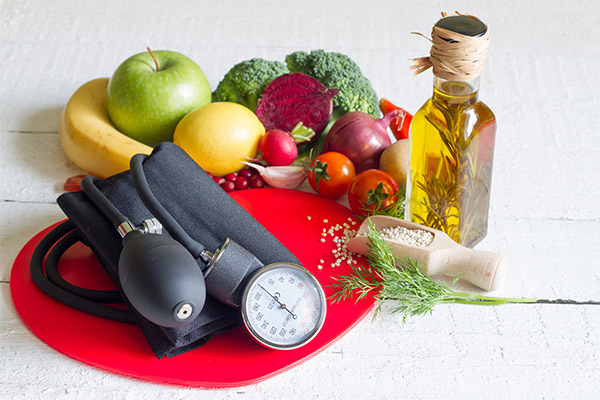
The presence of the following dishes and products in the diet of patients with arterial hypertension is acceptable:
- Fruits, berries, dried fruits - eaten fresh or for cooking compotes, jellies, kissels - it is better to choose fruits that contribute to the reduction of BP (citrus fruits, bananas, apples, black chokeberry and currants).
- A variety of vegetables (except beans) - fresh as a side dish or stew - sweet peppers, carrots, pumpkin, garlic, borage.
- Fresh greens - as useful as the previous group, preferably used in salads, soups and side dishes (lettuce, celery stalks, basil, parsley, dill).
- Breads based on wheat, rye, bran, wholemeal, galette cookies and breads.
- The first course in a low-fat, lean broth, can be borscht, beet soup, dairy, vegetarian.
- Lean meat of beef, veal, rabbit, chicken, turkey - boiled or baked, but without crusts.
- Dairy and fermented dairy products - daily consumption is allowed, but cottage cheese or sour cream should have a low fat percentage.
- Buckwheat, oatmeal, millet and barley, pasta from durum wheat.
- Olive, sunflower, and corn oils of varying degrees of purity should be added to cooked food.
- Spices - ginger, cinnamon, coriander, turmeric, basil.
That is, the diet of hypertensive people is based on fruits, vegetables, berries - their amount should reach 800 g per day. To maintain potassium and magnesium content, use herculean flakes, milk, fresh cabbage and kernels of nuts.
What needs to be limited
Certain products can be present in the diet of hypertension sufferers, but only in small amounts. To these categories, experts have classified:
- Fats of animal origin, their complete absence is unacceptable, but more than 30 g of the total daily amount of lipids found in chicken liver, butter and eggs.
- Potato fruits, rice and semolina cereals - are high in starch and glycemic index.
- Refined sugar - no more than 40 g in 24 hours, replaced with honey and fructose.
- Fish roe includes a lot of salt and hard-to-digest fats, but because of the presence of omega-3 acids is still recommended for hypertensive people.
Doctors advise consuming all of the above no more than a couple of times in 7 days. Lightly salted and sea fish, vegetable pickles and red caviar are allowed once a month.
What not to eat at high blood pressure
From the diet should be completely excluded components that provoke increased stress on the nervous, cardiovascular and urinary systems. Such categories of foods include:
- Frozen semi-finished products, including pizzas, dumplings, chebureks.
- Pickles, sauerkraut, pickles, cheese - contain a huge percentage of hidden salts that contribute to swelling of the walls of the arteries, narrowing their lumen, which causes significant changes in blood pressure.
- Fruits of turnips, peas, lentils, chickpeas, soybeans, radishes and green onions - "wake up" the stomach, which increases gas formation and compression of the diaphragm.
- Game, pork, liver, margarine, lard, sausages and dry cured meats, clarified butter, rich broths, fatty milk - in the composition of the listed high percentage of animal fats, provoking excessive load on the digestion and excitation of the nervous system.
- Pastries, confectionery, chocolates, and ice cream contain fast carbohydrates and sugars that adversely affect blood vessels and the heart.
- Spicy hot spices, mustard, mayonnaise and soy sauces, ketchup - create arterial spasms and increase blood flow.
Forbidden products are removed from the menu of patients not only for the duration of treatment, but also as prevention in the future.
What can and what can not drink with hypertension
Drinks containing vitamins and minerals have a positive effect on the heart muscle and vascular walls. For patients with hypertension, experts recommend the use of the following drinks:
- Regular water. Thins the blood and improves not only its flow, but also the elasticity of blood vessels. Doctors recommend drinking a glass of warm liquid on an empty stomach - to activate the internal organs. It stabilizes blood pressure, and before going to bed it will reduce the likelihood of a heart attack.
- Mineral water. It is useful to drink non-carbonated water enriched with calcium and magnesium 2-3 times in 7 days.
- Freshly made juices from pomegranate, apple, cranberry, currant, pumpkin, beets, carrots. Strengthen the heart muscle, reduce cholesterol plaques.
- Red dry wines. Improve the component composition of the blood and maintain magnesium balance. If the blood pressure is higher than 150 mm Hg, the intake of such drinks is strictly forbidden, because it provokes hypertensive crises. If everything is normal, then doctors allow the use of a glass a couple of times a week.
- Green teas. Reduce the risks of thrombosis. Drink non-strength black kinds without added sugar.
- Fresh vegetables, berries, and fruits serve as the basis for a healthy drink - smoothies, which contain a higher percentage of pectin and fiber compared to juices.
Blood pressure-lowering drinks have an effect if the BP is slightly higher by 10-15 units. They help thin the blood, strengthen the heart and blood vessels. Such drinks include:
- Carcade - infusion of dried bracts of Sudanese rose;
- decoctions based on clover, chamomile, calendula and dried hawthorn;
- compotes of dried fruits without added sugar;
- Cranberry and currant morsels;
- mixtures of low-fat milk and turmeric, kefir and cinnamon.
The strength of the severity of hypotensive effects directly depends on the amount and frequency of consumption of therapeutic "nectars".
Elevated BP implies the exclusion of refined sugar, artificial flavorings and caffeine from the diet, i.e:
- hard alcohol;
- instant and brewed coffee;
- energy drinks;
- strong carbonated lemonades;
- hot chocolate;
- Store-bought juice packets.
These drinks negatively affect the function of the heart muscle and liver, because they increase blood pressure and reduce the function of the pancreas.
Top foods that lower blood pressure
The quality and nature of the diet affects the metabolism and water-salt metabolism. Blood pressure depends on the combination of both processes.
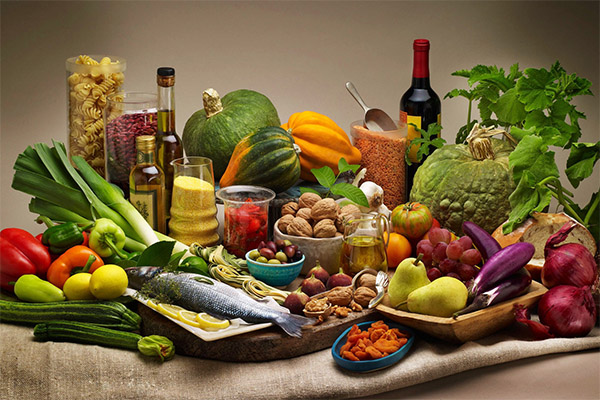
The final dietary restrictions depend on the patients' decisions, because no doctor has the right to force them. But doctors do insist on excluding certain foods and introducing others. Nutritionists help develop basic nutritional guidelines. Specialists often recommend the following list of foods for arterial hypertension.
Citrus
The fruits of lemons, oranges, tangerines, and grapefruit are preferred. The basis of their therapeutic effect is the effect on the state of the heart and blood vessels, which occurs due to:
- With a large amount of vitamin C, which protects the arteries and capillaries from destruction, by increasing the elasticity of tissues.
- Flavonoids - affect metabolic processes and serve as a moderate amount of atherosclerosis prevention.
Citrus fruits are eaten fresh or in the form of juices. Lemons are difficult to eat because of their high acid content. If desired, its slices are added to warm teas. The liquid should not be hot, otherwise the ascorbic acid will be destroyed.
Beets
The vegetable, like citrus fruits, has a lot of vitamin C, which plays the role of a strong antioxidant. It helps to prevent fatal changes associated with the destruction and degeneration of the vascular walls. Beets are a source of potassium. The element maintains electrolytic balance and regulates tissue tone.
It is better not to abuse the vegetable. When used inordinately, it provokes gastrointestinal disorders, because it is characterized by a pronounced laxative effect.
Spinach
In addition to a huge number of vitamins, the leaves and stems contain magnesium and potassium. They have strong electrolytic properties, help equalize BP and restore the elasticity of the vascular walls.
Garlic
The plant is a source of an essential compound, allicin. The substance gives the slices a sharp spicy taste and creates a burning sensation. It reflexively relaxes the vascular walls, which lowers BP, and after assimilation the positive effect is fixed.
The product has a diuretic effect, although not the most pronounced. Thanks to this property, extra fluid is eliminated from the body. It is necessary to eat 1-2 cloves daily.
Rosehip
Compotes, decoctions and infusions on the fruit of the shrub are sources of ascorbic acid, flavanoids, saponins, pectin and fatty oils. To make a drink, you must take 150 grams of rosehips and pour 600 ml of hot water, then strain and drink 100 ml before meals.
Chicory
This is the most useful drink for patients with hypertension. It serves as an alternative to coffee, because it contains vitamin C, pectin and carotene. Chicory normalizes the metabolism, relieves stress, eliminates insomnia and increases immunity. In a day you can drink 5 cups, at the rate of 3 tsp. per serving. But it is not recommended to drink the drink before going to bed.
Cocoa
This drink is a restorative and stimulates the nervous system. Unlike coffee, it contains theobromine. Cocoa prevents the adhesion of platelets and reduces the risk of heart attacks, cancer and diabetes. The drink is made from powder with more than 80% natural product content. Only 2 cups are allowed.
Ginger
The product has blood pressure normalizing properties. Its main constituents thin the structure of the blood, working as a natural antiplatelet. Also, ginger relaxes the vascular musculature and prevents spasms that provoke the growth of numbers on the tonometer.
Sea Buckthorn
The berries contain tannins, minerals, choline, flavonoids, vitamins, folic, caffeic and tartaric acid compounds. Sea buckthorn lowers blood pressure, because it strengthens blood vessels and has a diuretic effect. Freshly squeezed sea buckthorn juice lowers BP by 10 units when used regularly.
Curcuma
Spice is used for prevention and treatment. Curcuminoids gently reduce BP values without risks to the overall condition of the body.
Pomegranate
The fruit is characterized by its hypotensive properties. It is better to consume it in the form of juice - only 50 ml is needed. The composition contains an inhibitory compound - angiotensin, which narrows the walls of blood vessels and causes their artificial spasms. Magnesium and potassium - regulators of the water-salt balance, provoking a slight diuretic effect serve as a supplement.
Milk and kefir
One glass of natural, nonfat beverage should be drunk in a day. Ultrapasteurized type of sour milk products is better not to use, because it contains a high percentage of sugar. The effect of sour-milk products will not come immediately, but they help to reduce blood pressure gently and enrich the body with calcium.
In order to assimilate and reveal all the useful properties, the products are consumed in moderation. Lack or deficiency of nutrients is equally harmful to the human body.
Diets for hypertension
The main danger of high BP is the absence of clinical manifestations, which provokes the development of arrhythmia and coronary artery disease. The basis of therapeutic nutrition for hypertension is table #10 by Pevzner. The diet provides physiological norms of food and helps to normalize blood flow.
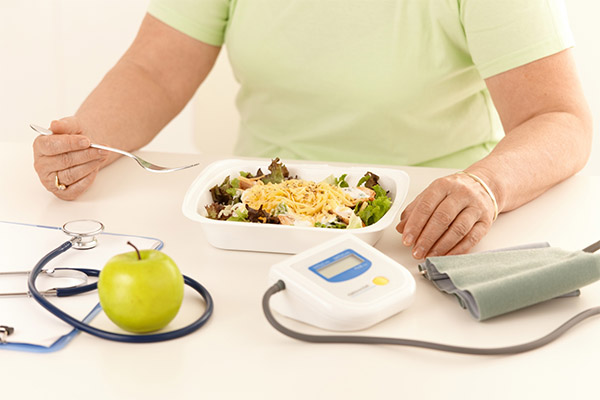
A properly composed diet not only stabilizes the level of pressure, but also improves metabolism, cleanses from toxins.
Nuances of the basic menu in the treatment of hypertension:
- The number of calories consumed per day should not exceed 2400.
- The ratio of proteins, fats and carbohydrates is determined by the average ratio of 80g/75g/350g.
- For obese patients, the calorie and FU content is lowered: the first reaches a maximum of 2100 kcal per day, and the second is in the range of 65/60/250g.
- Only already cooked food is salted.
- It is important to reduce the amount of NaCl, if such a restriction is difficult to give, the substance is replaced by potassium-magnesium analogues.
- Restriction also applies to foods with saturated fats, which are recommended to be replaced by polyunsaturated fatty acids, which serve as the basis for the synthesis of prostaglandins, contributing to improve blood quality.
- Enough water prevents vasoconstriction and increases BP.
Diets for frequent attacks of hypertension are fundamental in stabilizing high blood pressure readings and improving heart muscle health. Dietitians use Manuel Pevzner's recommendations, prescribed in Table No. 10, when formulating a diet plan. The therapeutic menu is divided into several varieties:
- A - for disease that is accompanied by circulatory system disorders and cardiovascular abnormalities.
- C - recommended for patients with all types of atherosclerosis and CHD, able to improve metabolism and prevent the formation of cholesterol plaques.
- D - with arterial hypertension in stages II-III, helps to stabilize BP to age normal.
In the initial stages of the disease and the absence of clinical manifestations of other chronic diseases is sometimes appointed diet № 15, characterized by a reduced amount of salt - no more than 5 g / day. The table is effective at the initial stage, completely excludes or delays drug treatment.
The main principles of the diet plan #15 are:
- Salt restrictions.
- Consumption of grain and bran types of bread, brown rice and pasta from durum wheat and dietary types of meat and fish - no more than 100 g per day.
- Inclusion of cereals, sprouted wheat and alfalfa, and nonfat dairy products.
- Replacing animal fats with vegetable fats.
Unlike table #10, this menu is characterized by a low daily caloric content of 1800-2000, so you can easily get rid of excess weight. The diet is often recommended for patients with obesity. Scientists have proven that dropping a kilogram lowers blood pressure by one point.
The menu of a hypertensive person, in addition to the mandatory meals, should include snacks that are light, quickly quench the feeling of hunger and support performance. Fresh or dried berries and fruits, pureed nuts, freshly squeezed juices and herbal decoctions will cope with these requirements. Before bedtime, it is advisable to consume a glass of kefir, ryazhenka or natural unflavored yogurt.
Salt-free tables involve the absolute exclusion of sodium chloride from the diet. This measure shows the following positive results:
- Improvements in the general condition of the body and skin;
- elimination of edema;
- lowering of BP;
- blood purification.
Also salt-free diet not only reduces excessive stress on blood vessels, heart and kidneys, but has some limitations:
- prolonged use is the cause of a disturbance in the water-salt balance;
- Only allowed in winter and autumn;
- Forbidden for patients under 18 years of age.
Before switching to such a table, mandatory consultation with a specialist.
Hypocholesterol diets prevent excessive accumulation of fluids, significantly lower cholesterol levels, stabilize blood pressure and ease the general well-being of the patient. The principle of the table is to limit the use of water, salt, and fatty foods. Each of the dishes is baked, and the number of meals is 6.
An important role belongs to the correction of the patient's already existing diet. Any diet for arterial hypertension is aimed at suppressing the general manifestations of the disease and is the main component of treatment along with medication.
Recipes for meals with hypertension
When the diet is followed, the symptomatology of the disease is reduced. Most often, a salt-free diet is recommended, which improves the overall performance of the human body. Anyone is able to independently prevent the course of the disease without the use of pills, you only need to eat properly prepared dishes.
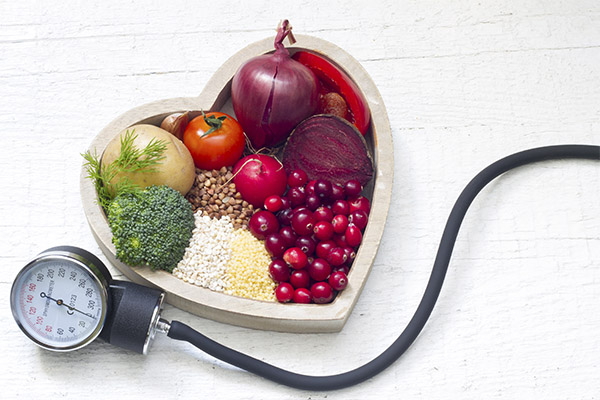
Salad "Tenderness"
You will need:
- Pumpkin - 100 g.
- Melon - 100 g.
- Apples - 100 gr.
- Lemon - 1/2 pc.
- Honey - 2 tbsp.
Peel the pumpkin, grate on the coarse side of the grater and mix with honey. Cut the apples, melon and lemon into thin, neat slices. Put all the chopped fruit in a salad bowl with the pumpkin and mix. The dish is ready.
Salad "Special"
What you need:
- Carrot - 2 small root vegetables.
- Apple - 2 pcs.
- Peeled walnuts - 50 g.
- Honey - 30 g.
- Greens - 20 grams.
Wash carrots, peel and grate or cut into fine julienne, mix with honey. Chop apples, parsley, walnuts and mix into a salad bowl. The salad is ready.
Baby's Joy Salad.
Need:
- Celery root - 150 g.
- Melon - 200 gr.
- Almond petals - 70 g.
- Carrots - 1 piece.
- Jam - 60g.
- Cranberries.
Peel celery root and carrots, wash and chop with a medium grater. Melon remove the skin and chop into small cubes. Mix all chopped in a salad bowl with the jam. Sprinkle with crushed almonds and garnish with cranberries.
Borsch on the basis of vegetable broth
You will need:
Water or vegetable broth - 2 liters.
- Beets - 1 pc.
- Celery - 1/2 pc.
- White cabbage - 150 gr.
- Potatoes - 3-4 pcs.
- Carrots - 1 pc.
- Lemon - 1/2 pc.
- Tomatoes - 3 pcs.
- Greens, spices - to taste.
Wash and peel the beets, cut them into thin julienne strips and sprinkle with the juice of half a lemon. Set it to stew. After 10-15 minutes add chopped celery, carrots and tomatoes. Leave on the heat for 12 minutes. Add shredded cabbage and potatoes to the stewed vegetables, pour the liquid - bring to the state of readiness. Before serving, sprinkle with greens and dress with nonfat sour cream if you wish.
Milk soup based on pumpkin and semolina
What you need:
- Peeled pumpkin - 200 g.
- Milk - 700 ml.
- semolina - 50 gr.
- Sugar - 20 gr.
- Butter - 10 gr.
- Water - 100 ml.
Carefully cut and dice pumpkin, pour water on it and simmer until it is ready. Then rub it through a sieve until it becomes a liquid sour cream. Bring milk to a boil and pour semolina. Boil for 10-12 minutes and combine with pumpkin puree, add butter and sprinkle with sugar before use.
Fruit soup with rose hips
What is needed:
- Peeled apples - 150 g.
- Dried rosehips - 25 gr.
- Sugar - 15 gr.
- Cinnamon - 1 gr.
- White bread - 40 gr.
- Water - 500 gr.
Scald the rose hips. Then boil for about 5 minutes and leave to infuse for about 4 hours. Strain and add cinnamon powder, sugar, grated apples. Bring to the boil and leave to cool. Cut the bread into small cubes and put in the oven. Serve bread crumbs together with cooled soup.
Beef in author's sauce
You will need:
- Beef meat - 300 gr.
- Butter - 10 gr.
- Low fat sour cream - 45 gr.
- Wheat flour - 10 gr.
- Raisins - 20 gr.
- Prunes - 30 gr.
- Apple - 1/4 piece.
- Dill - 10 gr.
- Vegetable broth - 200 ml.
Wash the meat, cook until tender and cut into portions. Proceed to make the sauce. Soak the prunes and raisins in boiling water. Melt butter with flour and water on medium heat and put chopped meat and sour cream. Then pour chopped fruit and stew for 8-10 minutes. Before serving, sprinkle the dish with chopped dill.
Diet Steak
What you need:
- Veal loin - 250 g.
- Onions - 1 pc.
- Butter - 30 gr.
Cut the loin into two pieces and beat it with a kitchen hammer until it becomes a pancake. Put meat on non-stick cooking utensils, pour water on half of it and over low heat bring it to half-cooked state. Then add to the pan with the fried onions and finish cooking. The veal should have a barely visible brown crust. As a side dish serve stewed vegetable stew or durum wheat pasta.
Fillet of pikeperch in a mild cream sauce
What you need:
- Perch - 200 g.
- Butter - 15 gr.
- Cream 10% - 90 ml.
- Milk - 50 ml.
- Flour - 10 gr.
- Potatoes - 100 gr.
- One chicken egg - 1 egg.
- Lean cheese - 20 g.
Cut fish fillet into 3-4 pieces and boil it. Put zander on non-stick frying pan and pour cream sauce over it. To make the latter, melt butter in a saucepan, pour in cream and thicken with flour. Sprinkle the grated cheese over the puffed fish and put it in the oven for 3-5 minutes until it becomes slightly crispy. Mashed boiled potatoes with milk and egg with a blender. Sprinkle the ready garnish with herbs and serve with a delicious pikeperch fillet.
Unbeatable casserole.
Need:
- Apples - 150 g.
- Raisins - 25 gr.
- Figs - 1/2 piece.
- Cottage cheese - 100 gr.
- Butter - 20 gr.
- Sugar - 15 gr.
- Mann grits - 10 gr.
- Carrots - 1/2 piece.
- Spinach - 30 gr.
- Sour cream - 25 gr.
Rinse and grate carrots on the fine side of a grater. Stew them in water with oil until they are ready. Add shredded spinach leaves. Leave on the fire for 5-7 minutes and mix with the chopped apples and figs. Make a mixture of semolina, eggs, raisins and sugar. Lightly oil the baking dish and alternate the pieces. Put in the oven for 15-20 minutes, checking the readiness with a wooden skewer - it should be dry. Serve with a little jam, berry syrup or low-fat sour cream.
«Important: All information on this website is provided solely for informational for information purposes only. Consult with a health care professional before using any recommendations. specialist before using any of the recommendations. Neither the editors nor the authors shall be liable for any possible harm caused by materials."

